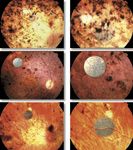Article
Favorable results persist with implant
Fort Lauderdale, FL—Follow-up in the first 10 patients with the Artificial Silicon Retina microchip (ASR, Optobionics) implanted now ranges between 2 and 4.5 years.

During that time, the device continues to be well-tolerated, all 10 patients have experienced some persistent objective visual function improvement, and nine have noted subjective improvements, reported Alan Y. Chow, MD, at the annual meeting of the Association for Research in Vision and Ophthalmology.
"Not only has it been exciting that these patients appear to have improved vision over their baseline vision despite a variety of retinitis pigmentosa (RP) conditions, but it is notable that none has experienced any vision deterioration in the eye with the implant, although vision loss has occurred in some of the fellow eyes," said Dr. Chow, assistant professor, department of ophthalmology, Rush University Medical Center, Chicago.
The ASR microchip is a photodiode-based device designed to stimulate contacting retinal cells electrically upon exposure to incident light.
The device measures 2 mm in diameter, is 25 µm thick, and is embedded with about 5,000 electrode-tipped, isolated microphotodiodes. The ASR microchip is implanted in the subretinal space 20° from the macula.

All of the surgeries were performed at the Rush University Medical Center, the University of Illinois, and Central Dupage, a community hospital. They were done in three sessions: three eyes received implants in June 2000, another three received the ASR microchip in July 2001, and the last four procedures were performed in November 2002.
Preoperatively, only one patient was able to read ETDRS letters with the right eye and three could read letters with the control left eye. Acuity improvements occurred early after surgery, but often peaked at 1 to 6 months, and then partially declined.
However, at their last follow-up, six patients read increased letters with the eyes with the implant compared with only one at baseline; whereas in the fellow control eyes, there was a slight increase in letters read in one eye, and a substantial drop in two eyes.
Since ETDRS testing is limited to detecting changes of visual acuity of better than 20/1600, a grating acuity test was developed for four patients that tested from 20/800 to 20/16000. Two of those four patients had grating acuity improvements that were still present at 2 years after surgery.
Improvement in automated visual field testing was noted early after surgery in two patients, but the benefit had substantially regressed by 24 months.
Newsletter
Don’t miss out—get Ophthalmology Times updates on the latest clinical advancements and expert interviews, straight to your inbox.





